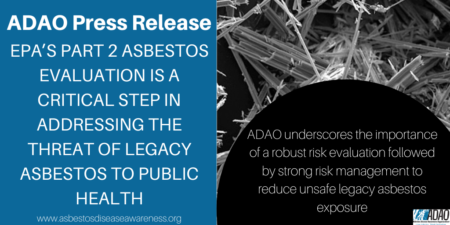ADAO FAQs: WHAT TO KNOW ABOUT EPA’s TSCA PART 2 LEGACY ASBESTOS EVALUATION
EPA’S PART 2 ASBESTOS EVALUATION IS A CRITICAL STEP IN ADDRESSING THE THREAT OF LEGACY ASBESTOS TO PUBLIC HEALTH
ADAO underscores the importance of a robust risk evaluation followed by strong risk management to reduce unsafe legacy asbestos exposure
 April 15, 2024 — WASHINGTON, DC — The Asbestos Disease Awareness Organization (ADAO), independent nonprofit dedicated to preventing asbestos exposure through education, advocacy, today welcomed the Environmental Protection Agency’s draft of its Risk Evaluation for Asbestos Part 2 as step forward in the battle to protect Americans from deadly asbestos, which is responsible for more than 40,000 deaths in the United States every year.
April 15, 2024 — WASHINGTON, DC — The Asbestos Disease Awareness Organization (ADAO), independent nonprofit dedicated to preventing asbestos exposure through education, advocacy, today welcomed the Environmental Protection Agency’s draft of its Risk Evaluation for Asbestos Part 2 as step forward in the battle to protect Americans from deadly asbestos, which is responsible for more than 40,000 deaths in the United States every year.
“This draft evaluation is long overdue,” said Linda Reinstein, co-founder and President of ADAO. “We have done far too little to understand how and where Americans are being exposed to legacy asbestos that lurks in our homes, schools, workplaces and in consumer products. Legacy asbestos exposure poses a serious danger to public health and can be responsible for numerous asbestos-caused diseases including, cancers, mesothelioma and lung disease.”
“ADAO experts will closely review the draft evaluation to ensure it is based on the latest science on asbestos hazards and the best available information on legacy asbestos exposure. Any gaps or deficiencies in the draft will be brought to EPA’s attention by our official comments because science shows that even trace amounts of asbestos are harmful. EPA’s part 2 risk analysis for legacy asbestos must be strong, rigorous and comprehensive to truly protect public health,” she finished.
The Part 2 evaluation examines the risks of asbestos-containing products that are no longer sold but were manufactured during the decades when asbestos was widely used throughout our economy. Millions of workers and consumers may be exposed to asbestos from these legacy products, often unknowingly and without any precautions to prevent exposure.
In a sharp break with EPA’s first 10 risk evaluations under TSCA, the Agency did not seek any independent scientific peer review of the draft evaluation. ADAO and other organizations raised concerns with EPA leadership about this lack of independent oversight.
“Policymakers and public health experts will look to Part 2 for authoritative guidance on the ongoing health threats from legacy asbestos, but the absence of independent peer review raises questions about the evaluation’s completeness and scientific validity,” noted Bob Sussman, ADAO counsel and former senior EPA official.
EPA’s draft evaluation determines that exposure to legacy asbestos presents an unreasonable risk of injury to human health stating: “determined that disturbing and handling asbestos associated with legacy uses, and asbestos as a whole chemical, poses unreasonable risk to human health,” a conclusion that ADAO strongly supports. If EPA’s final evaluation affirms this finding, TSCA requires it to conduct a risk management rulemaking to eliminate the unreasonable risk.
In November 2019, in a case filed by ADAO and other groups, the Ninth Circuit Court of Appeals held that EPA’s exclusion of legacy uses and associated disposals “contradicts TSCA’s plain language.” Rather than including it in their Part 1 Risk Evaluation for Asbestos, EPA chose to defer legacy asbestos to a separate Part 2 evaluation. When EPA failed to set a timeline for Part 2, ADAO and its partners again sued the Agency. The suit resulted in a settlement that led to a consent decree in late 2021 obligating EPA to complete the Part 2 evaluation by December 1, 2024.
While Part 1 only applies to chrysotile fibers, Part 2 addresses not just chrysotile, but all other asbestos fiber types including the asbestiform varieties of crocidolite (riebeckite), amosite (cummingtonite-grunerite), anthophyllite, tremolite and actinolite, plus richterite and winchite-asbestos. These fibers must be included in Part 2 because of their historical role in manufacturing asbestos-containing products that are still in use. Effective protection against ongoing, as well as legacy uses of asbestos, cannot be limited to chrysotile but must address all asbestos fiber types.
Currently, an uneven patchwork of federal and state laws and regulations apply to the handling and removal of legacy asbestos.
“The risk management process will be a unique opportunity for EPA, stakeholders and leading experts to join forces to build public awareness of the threat of legacy asbestos and how to manage it more safely. We can and must do a better job of saving lives through stronger public education and more protections for at-risk first responders, construction workers repairing, renovating or demolishing older buildings, janitors servicing older HVAC systems, and teachers and students in older schools built with asbestos,” Reinstein stated.
For more information about the Part 2 Risk Evaluation for Asbestos, please read our FAQs.
###
